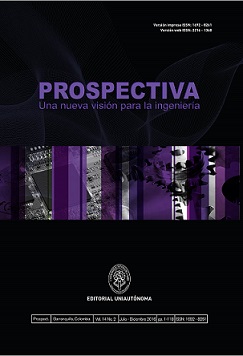Study of scavenging capacity of naringin extracted from Citrus aurantium peel against free radicals /Estudio de la actividad antioxidante de la naringina extraída de la cáscara de Citrus aurantium contra radicales libres
DOI:
https://doi.org/10.15665/rp.v14i2.677Palabras clave:
Naringin, free radicals, ABTS, Citrus aurantiumResumen
In this work we determined free radical scavenging of the Citrus Aurantium peel (orange peel) extract. Naringin was isolated from the fruit peel from Citrus aurantium for using liquid-liquid solvent extraction method; it was characterized by spectroscopic techniques (UV-vis and FT-IR analysis). The scavenging free radical of naringin was evaluated by monitoring radical cation bleaching of ABTS•+ by visible spectroscopy at 734 nm. Assays were compared to reference antioxidants BHT, α-tocopherol and Trolox. Results indicated a minimal extract concentration of 5.0x103 was required to present antioxidant activity; furthermore, results also showed the extract from the peel of citrus aurantium has antioxidant activity against free radicals, under our experimental conditions, naringin extract had scavenging free radicals of 43.06% and best reference antioxidant had scavenging free radicals of 50.36%.
Citas
T. Herraiz, J. Galisteo. “Hydroxyl radical reactions and the radical scavenging activity of B-carboline alkaloids”. Food Chemistry, 172, 640–649, 2015.
J. B. Jeong, E. W. Seo, H. J. Jeong. “Effect of extracts from pine needle against oxidative DNA damage and apoptosis induced by hydroxyl radical via antioxidant activity”. Food and Chemical Toxicology, 47, 2135–2141, 2009.
M. Özyürek, B. Bektasoglu, K. Güclü, R. Apak. “Hydroxyl radical scavenging assay of phenolics and flavonoids with a modified cupric reducing antioxidant capacity (CUPRAC) method using catalase for hydrogen peroxide degradation”. Analytica chimica acta, 616, 196–206, 2008.
M. Schrag, C. Mueller, M. Zabel, A. Crofton, W.M. Kirsch, O. Ghribi, R. Squitti, G. Perry. “Oxidative stress in blood in Alzheimer's disease and mild cognitive impairment: A meta-analysis”. Neurobiology of Disease, 59, 100-110, (2013).
G. Chen, L. Ren, J. Zhang., B. M. Reed, D. Zhang, X. Shen. “Cryopreservation affects ROS-induced oxidative stress and antioxidant response in Arabidopsis seedlings”. Cryobiology, 70, 38–47, 2015.
P. Sunkireddya, S. N. Jhab, J. R. Kanwar, S. C. Yadav. “Natural antioxidant biomolecules promises future nanomedicine based therapy for cataract”. Colloids and Surfaces B: Biointerfaces, 112, 554–562, 2013.
F. M.F. Roleira, E. J. Tavares, C. L. Varela, S. C. Costa, T. Silva, J. Garrido, F. Borges . “Plant derived and dietary phenolic antioxidants: Anticancer properties”, Food Chemistry, 183, 235–258, 2015.
J. Li, S. Fan, Z. Qiu, C. Li, S. Nie. “Total flavonoids content, antioxidant and antimicrobial activities of extracts from Mosla chinensis Maxim. cv. Jiangxiangru”, LWT - Food Science and Technology, 64, 1022-1027, 2015.
M. Iranshahi, R. Rezaee, H. Parhiz, A. Roohbakhsh, F. Soltani. “Protective effects of flavonoids against microbes and toxins: The cases of hesperidin and hesperetin”, Life Sciences, 137, 125–132, 2015.
D. Ravishankar, A. K. Rajora, F. Greco, Helen. M.I. Osborn. “Flavonoids as prospective compounds for anti-cancer therapy”, The International Journal of Biochemistry & Cell Biology, 45, 2821–2831, 2013.
M. Bacanlı, A. A. Başaran, N. Başaran. “The antioxidant and antigenotoxic properties of citrus phenolics limonene and naringin”, Food and Chemical Toxicology, 8, 160–170, 2015.
T. H. Kim, S. J. Jang, H. Chung, H. Kim, H. Yong, W. Choe, C. Jo. “Enhancement of antioxidant effects of naringin after atmospheric pressure dielectric barrier discharge plasma treatment”, Bioorganic & Medicinal Chemistry Letters, 25, 1236–1239, 2015.
P. Thangavel, R. Muthu, M. Vaiyapuri, “Antioxidant potential of naringin – a dietary flavonoid – in N-Nitrosodiethylamine induced rat liver carcinogenesis”. Biomedicine & Preventive Nutrition, 2, 193–202, 2012.
Ikan R. Acetogenins in Natural Products, Academic Press, London and New York editorsr, 1969, pp. 45-60.
N. Miller, C. Rice-Evans. “Factors Influencing the Antioxidant Activity Determined by the ABTS•+ Radical Cation Assay”, Free Radical Research, 26, 195-9, 1997.
Liangli L. Yu (Editor). Wheat Antioxidant. ISBN: 978-0-470-04259-5 Wiley editors, 2007, pp. 129.
Özyürek M, Akpınar D, Bener M, Türkkan B, Güçlü K, Apak R. “Novel oxime based flavanone, naringin-oxime: Synthesis, characterization and screening for antioxidant activity”. Chem-Biol. Interact. 212, 40-46, 2014.
P.L. Muthiah, M. Umamaheswari, K. Asokkumar “In vitro antioxidant activities of leaves, fruits and peel extracts of Citrus”, International Journal of Phytopharmacy, 2, 13-20, 2012.
V. Roginsky, E.A. Lissi, “Review of methods to determine chain-breaking antioxidant activity in food”. Food Chemistry, 92, 235-254, 2005.
A. Bocco, M. E. Cuvelier, H. Richard, C. Berset, “Antioxidant activity and phenolic composition of citrus peel and seed extracts”, Journal of Agricultural Food Chemistry, 46, 2123-2129, 1998.
Descargas
Archivos adicionales
Publicado
Número
Sección
Licencia
Los autores/as que publiquen en esta revista aceptan las siguientes condiciones:
- Los autores/as ceden los derechos de autor y dan a la revista el derecho de la primera publicación, con el trabajo registrado con la licencia de atribución de Creative Commons, que permite a terceros utilizar lo publicado siempre que mencionen la autoría del trabajo y a la primera publicación en esta revista.
- Los autores/as pueden realizar otros acuerdos contractuales independientes y adicionales para la distribución no exclusiva de la versión del artículo publicado en esta revista (p. ej., incluirlo en un repositorio institucional o publicarlo en un libro) siempre que indiquen claramente que el trabajo se publicó por primera vez en esta revista.
- Se permite y recomienda a los autores/as a publicar su trabajo en Internet (por ejemplo en páginas institucionales o personales) antes y durante el proceso de revisión y publicación, ya que puede conducir a intercambios productivos y a una mayor y más rápida difusión del trabajo publicado (vea The Effect of Open Access).
Instrucciones para el llenado de la Certificación de Originalidad y la Cesión de Derechos de Autor.
- Haga click aquí y baje el formulario de Certificación de Originalidad y la Cesión de Derechos de Autor.
- En cada uno de los campos para rellenar haga click y complete lo correspondiente.
- Una vez llenos los campos, copie al final su firma escaneada o firma digital. Favor ajustar el tamaño de la firma en el formulario.
- Finalmente, lo puede guardar como pdf y enviarlo a través de la palataforma OJS, como archivo complementario.
Si tiene dudas contáctenos, por favor.


